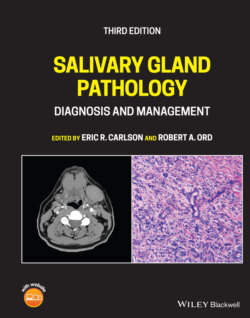Читать книгу Salivary Gland Pathology - Группа авторов - Страница 23
CONTENTS OF THE PAROTID GLAND Facial Nerve
ОглавлениеFrom superficial to deep, the facial nerve, the auriculotemporal nerve, the retromandibular vein, and the external carotid artery pass through the substance of the parotid gland.
The facial nerve exits the skull base at the stylomastoid foramen. The surgical landmarks are important (Figure 1.4). To expose the trunk of the facial nerve at the stylomastoid foramen, the dissection passes down the avascular plane between the parotid gland and the external acoustic canal until the junction of the cartilaginous and bony canals is palpated. A small triangular extension of the cartilage points toward the facial nerve as it exits the foramen (Langdon 1998b). This is the so‐called tragal pointer. The main trunk of the nerve lies approximately 13.6 mm from this landmark but there is considerable variation (Ji et al. 2018). The nerve lies about 9 mm from the posterior belly of the digastric muscle where the digastric passes deep to the sternocleidomastoid muscle, and 11 mm from the bony external meatus (Holt 1996). The facial nerve then passes downwards and forwards over the styloid process and associated muscles for about 1.3 cm before entering the substance of the parotid gland (Hawthorn and Flatau 1990). The first part of the facial nerve gives off the posterior auricular nerve supplying the auricular muscles and also branches to the posterior belly of the digastric and stylohyoid muscles.
On entering the parotid gland, the facial nerve divides into two divisions, temporofacial and cervicofacial the former being the larger. The division of the facial nerve is sometimes called the pes anserinus due to its resemblance to the foot of a goose. From the temporofacial and cervicofacial divisions, the facial nerve gives rise to five named branches – temporal, zygomatic, buccal, mandibular, and cervical (Figure 1.5). The peripheral branches of the facial nerve form variable anastomotic arcades between adjacent branches to form the parotid plexus. These anastomoses are important during facial nerve dissection as accidental damage to a small branch often fails to result in any facial weakness due to dual innervation from adjacent branches. Davis et al. (1956) studied these patterns following the dissection of 350 facial nerves in cadavers. The anastomotic relationships between adjacent branches fell into six patterns (Figure 1.6). They showed that in only 6% of cases (type VI) is there any anastomosis between the mandibular branch and adjacent branches. This explains why, when transient facial weakness follows facial nerve dissection, it is usually the mandibular branch that is affected.
